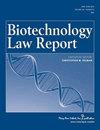太平洋。加利福尼亚州生物科学股份有限公司诉牛津纳米孔技术公司。,股份有限公司美国联邦巡回上诉法院,2021年《联邦公报》第3版第996页第134页
IF 0.3
4区 生物学
Q4 BIOTECHNOLOGY & APPLIED MICROBIOLOGY
引用次数: 0
摘要
加利福尼亚州太平洋生物科学股份有限公司(PacBio)起诉牛津纳米孔技术股份有限公司和牛津纳米孔科技有限公司(统称牛津),指控牛津侵犯其多项专利,包括美国专利9546400和9772323。这些专利描述并要求保护使用纳米孔技术对DNA和其他核酸进行测序的方法。陪审团认定所有声称的索赔都受到了侵犯,但也认定根据《美国法典》第35卷第112节,由于缺乏授权,这些索赔无效。地区法院驳回了PacBio关于授权的法律判决动议(以及新的审判)。地区法院还拒绝了PacBio要求法院批准重新审判的请求,因为牛津大学在开庭时发表了不当言论,其中包括提及其被控产品在当时正在合并的全球新冠肺炎危机中的潜在应用。PacBio辩称,这些言论造成了偏见,而地区法院应PacBio的要求给出的治疗指示无法弥补这种偏见。在上诉中,联邦巡回法院予以确认。关于启用,法院指出,仅仅让相关的工匠知道如何表演是不够的“纳米孔测序”是在专利的优先权日之前进行的,陪审团有大量证据表明其未实现全部权利要求范围。值得注意的是,PacBio没有证据表明其实际减少到实践中,这会破坏牛津大学的未实现证据。正如PacBio所承认的,其减少到实践只是建设性的,即采取了其在atent应用程序,而不伴随任何现实世界中的实践减少。联邦巡回法院认为,没有任何依据可以干扰地区法院的评估,即不当的开场白对最终判决产生不利影响的可能性不足以证明对本案进行新的审判是合理的。本文章由计算机程序翻译,如有差异,请以英文原文为准。
Pac. Biosciences of California, Inc. v. Oxford Nanopore Techs., Inc. United States Court of Appeals of the Federal Circuit, 2021 996 F.3d 134
Pacific Biosciences of California, Inc. (PacBio) sued Oxford Nanopore Technologies, Inc. and Oxford Nanopore Technologies, Ltd. (collectively, Oxford), accusing Oxford of infringing several of its patents, including U.S. Patent Nos. 9,546,400 and 9,772,323. The patents describe and claim methods for using nanopore technology to sequence DNA and other nucleic acids. A jury found all asserted claims infringed but also determined that they are invalid under 35 U.S.C. 112 for lack of enablement. The district court denied PacBio's motion for judgment as a matter of law (and for a new trial) on enablement. The district court also denied PacBio's request that the court grant a new trial because of Oxford's improper remarks during opening, remarks that included references to the potential applications of its accused products to the then-emerging global COVID-19 crisis. PacBio argued that the remarks caused prejudice that could not be remedied by the curative instruction the district court gave at PacBio's request. On appeal, the Federal Circuit affirmed. Regarding enablement, the court noted that it is not enough that relevant artisans knew how to perform some "nanopore sequencing'' before the priority date of the patents, and that the jury had substantial evidence of non-enablement of the full claim scope. Notably, PacBio had no evidence of actual reduction to practice of its own that would undermine Oxford's evidence of non-enablement. As PacBio acknowledged, its reduction to practice was constructive only, i.e., took the form of its description in patent applications, without any accompanying real-world reduction to practice. The Federal Circuit did not see a basis for disturbing the district court's assessment that there was an insufficient likelihood that the improper opening remarks had an adverse impact on the ultimate verdict to justify a new trial in this case.
求助全文
通过发布文献求助,成功后即可免费获取论文全文。
去求助
来源期刊

Biotechnology Law Report
工程技术-生物工程与应用微生物
CiteScore
0.30
自引率
0.00%
发文量
31
审稿时长
>12 weeks
期刊介绍:
The leading authoritative journal since 1982 devoted to the evolving body of law and government regulation concerning biotechnology, particularly in the industries in which new products from these technologies are developing the most rapidly: pharmaceuticals, chemicals, agriculture, food processing, energy, mineral recovery, and waste treatment. All legal aspects are rapidly reported, and critical and often hard-to-obtain documents are reproduced.
 求助内容:
求助内容: 应助结果提醒方式:
应助结果提醒方式:


